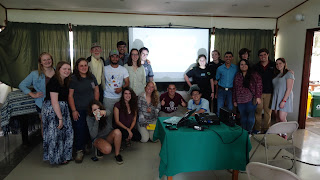This forest is unique in that it is a retired farm! As such, it is dominated by secondary growth. The transects that we set in this forest were particularly difficult to navigate and maneuver through due to the high amounts of young trees and undergrowth that dominate a newly recovered forest. Unlike some of the other secondary forests we have set traps at, there were more Heteromys spp. captured. This is particularly unique because Heteromys tend to populate more in mature, wet forests. It is important to note, however, that Finca Rodriguez is very shady despite its recovery status. This shade provides good grounds for roaming mice that are hiding from predators as they hunt for food- namely, seeds or insects. This explains our success in trapping rodents at this location with at least 4-6 mice in each transect every morning. Finca Rodriguez's ample shade and undergrowth also likely explains how some of the mice trapped at this location were caught in the afternoon, something that does not happen often seeing as how rodents are primarily active during the evening and early morning. All in all, the Finca forest was one of our most successful trapping locations!
In addition to trapping, we also had the pleasure and privilege of mist netting for birds in the Finca Rodriguez. After a bit of waiting, we were able to catch two species of birds: one Golden-crusted Warbler and one juvenile Rufous and White Wren. Both were smaller species, but that is to be expected with the size of the nets we were using. Typically, only larger birds of prey are caught in the small nets by accident when they try to eat the smaller birds already caught in them... During this process, we learned about how mist netting is especially useful for gathering information about bird diets, disease, tagging for migration, and much more! This was a special opportunity to learn about field-research methods as well as the chance to get to hold a wild bird! This, of course, is a privilege because these nets are not used often. In fact, we learned that scientists try to use mist nets as little as possible because they cause the animals caught in them a great deal of stress, and in some cases, can result in harm or death. Fortunately, this only happens in rare cases and thus was not a problem for us. Both birds were caught, handled, and released safely and successfully.
 |
| The first bird of the morning: a juvenile Rufous and White Wren. |
 |
| Brian holding a Golden-crested Warbler! |


No comments:
Post a Comment